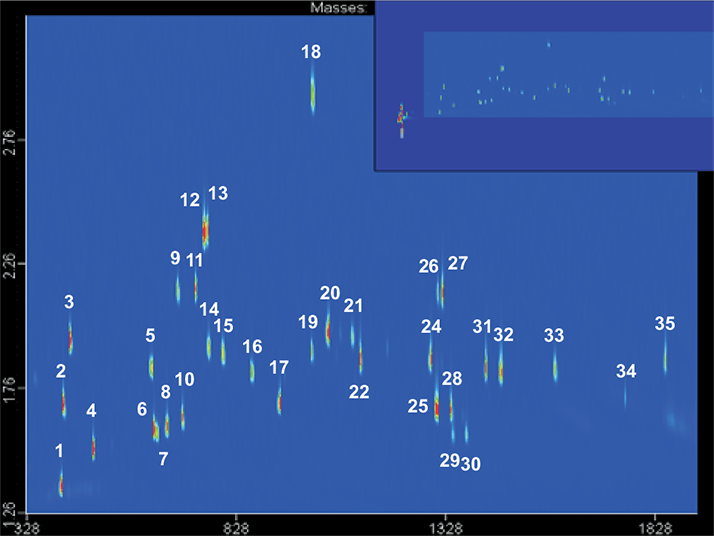Introduction
Fragrances are complex mixtures that are part of everyday life. From cosmetics to household products, chemicals that produce scent are present at various levels, but little is known about their composition since fragrance formulas are considered trade secrets. New health concerns about allergic reactions caused by chemicals present in fragrances of synthetic or natural origin (it is estimated that 1 to 2% of the population has allergies to fragrance) have led to an increased interest in the analysis of perfumes. The 7th Amendment of the EuropeanCosmetics Directive requires the declaration of the listed 26 "fragrance allergens" (24 defined volatile substances and 2 botanicals) if they exceed specified levels. As a result, a project was initiated at the end of 2001 within the International Fragrance Association (IFRA) to develop a method for the analysis of "fragrance allergens", with the purpose of defining a way to determine and regulate their presence.

Comprehensive two-dimensional gas chromatography (GCxGC) provides the additional peak capacity necessary to elucidate the composition of complex sample mixtures. Two separation mechanisms (primary and secondary columns of different phases) are employed to aid in the analysis of such complex samples. With thermal modulation (after the primary column), peak widths at the end of the second column are typically on the order of 100 ms, and fast data acquisition systems are required. A Timeof- Flight Mass Spectrometer (TOFMS) is the onlyMS capable of acquisition rates up to 500 spectra/second, adequate for the characterization of peaks with lowmswidths. For this study of allergens in a perfume, two different secondary columns were tested (DB-WAX and VB-210) while the first column was kept as a constant (Rtx-5MS). This study is concerned with the detection in perfumes of 24-targeted compounds and 3 additional volatiles with other regulatory concerns. A GCxGC-TOFMS system is used to find, identify, and quantify the presence of all components in one analysis.
Experimental Conditions
All other parameters are listed in Table 1 as a function of column type used in the second dimension.
Results
Qualitative Analysis In addition to the 24 targeted allergenic compounds, the standard mixture included 11 additional components.
- 2 internal standards to be used for quantification
- 5 impurities (isomers of the targeted compounds) present in the standard used for the preparation of the mixture
- 3 carcinogenic compounds
- 1 component (benzeneacetaldehyde) sought to be added on the targeted allergens list
All 35 components present in the standard mixture along with their retention times (Rtx-5/DB-WAX) and unique masses are listed in Table 2. Figures 1 and 3 show the total ion current (TIC) chromatograms as contour plots for the two different column configurations. Peak intensity is color scaled in the figures from blue to red, with red representing the highest intensity.
 Figure 1. TIC chromatogram of the standard mixture on the column set Rtx-5/VB-210. The chromatogram on the upper right corner is the full-scale chromatogram with the highlighted region representing the zoomed display. Peak numbers are the same as in Table 2.
Figure 1. TIC chromatogram of the standard mixture on the column set Rtx-5/VB-210. The chromatogram on the upper right corner is the full-scale chromatogram with the highlighted region representing the zoomed display. Peak numbers are the same as in Table 2.




